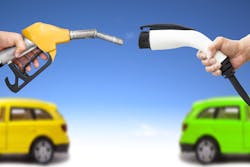Vehicle tech report gives aftermarket CEOs two choices over strategic direction
EV does it, car techies! Due to another run-up of new electric vehicle sales, the automotive aftermarket industry is approaching a crossroads, notes a research study conducted by Roland Berger, an automotive consultancy.
“We noticed that aftermarket executives had very similar questions and topics that were top of mind for them, but that for which very little information was available,” said Neury Freitas, principal researcher for Roland Berger.
That leaves product strategists with two options: either promote all-electrics or defend petrol power. Freitas contends that taking a long-view strategy over what happens next in the auto parts industry undoubtedly presents some trade-offs.
Suppliers dedicated to their internal combustion engine know-how could remain the last company standing selling mechanical components to the OEMs. Or a company can choose to support electrification and invest in research and development. Making matters less predictable, the digital mash-up of technologies is pulling the global automotive car parc in different directions.
Roland Berger identifies as many as 10 overlapping indicators that will continue to drive evolution. But for simplicity, Freitas encourages decision makers to act along the lines of positioning, performance and progression.
Titled “A Forward Look at the Auto Parts Industry,” the study foresees the global automotive roadways populated by seven percent of EVs by 2040. Approximately 60 percent will be driving internal combustion autos, with hybrids accounting for the balance. However, notes the report, “significantly lower mechanical costs in BEVs will have a negative impact on future aftermarket spend.”
The steady entry of EVs leaves 10 to 15 years for retailers, manufacturers, and service providers to repurpose their business models. Freitas told Aftermarket Business World that “to differentiate between what really matters and what’s only noise” will separate the long-term companies from those “without a clear strategy.”
Selling hard parts could become less attractive than the potentially disruptive nature of available technologies. Mobility, autonomous driving, digitalization, and electrification are transforming the classic automotive transportation segment in ways that may unseat how companies conduct business, the reporting finds.
Specifically in the United States, service providers and aftermarket suppliers stand to benefit from new revenue streams exclusive to battery electric vehicles. The study predicts that by 2024, as technology stabilizes, an emerging marketplace surpassing $250 billion presents new money-making opportunities that include battery remanufacturers and repair hubs for electric driving components.
Sensor maintenance and repair jobs related to anti-collision vehicle software present a sizeable potential to service upwards of 75 million vehicles by 2029. The sweet spot for aftermarket suppliers hinges on how effectively they promote application equipment for autonomous driving components and training for specialty repair hubs.
E-commerce orders are outpacing most other sales channels.
Online transactions for auto parts soared at an annualized rate of 21% from 2012 to 2019, reports Roland Berger. DIY-focused Amazon grew twice as fast as the rest of the online market, in which the leading platform netted sales beyond $12 billion over the past 10 years. But now, the research findings indicate that Amazon has redirected its “Prime” fulfillment promise to the do-it-for-me customer. The author believes that this could pose a greater threat to the traditional aftermarket business.
Consequently, to that end, Amazon is developing an online-to-offline business model by securing installer relationships on fast-moving categories. As of November 2021, at the report's release, the e-tailer has partnered with 3,500 tire installers, including Monro and Pep Boys. Driven by Amazon’s overnight delivery promise, shoppers can place an order and have the tires shipped directly to the desired outlet for service.
The hurdles facing the traditional automotive aftermarket, the report cautions, boils down to competing with the digital disrupters eager to please customer expectations. Success over winning online shoppers depends on efficient digital marketing content that speaks directly to the shopper, promotes a universal price regardless of the channel shoppers use, and executes a flexible just-in-time shipment model.
Part of the omnichannel challenge has led Roland Berger to raise concerns about the increasing complexity of maintaining a profitable pricing strategy. Transparent online price comparisons are now the norm. Cost-plus matrixes cannot outperform many of the e-commerce platforms that use big data and sophisticated software tools.
This digital divide has captured the attention between those managers who have access to data and those lacking it. The report surveyed an undisclosed number of suppliers, in which 90 percent say they cannot obtain the data they require. Such disparities could hamper suppliers from deciding what products to make or forecasting where the opportunities exist in the value chain. Cautioned Freitas, “many companies that claim to use a competitive pricing approach don’t have competitive data,” which may create omnichannel conflicts.
Real-time vehicle telematics data is attracting a growing share of mobility consumers by connecting them to a widening class of service providers. Launched in 2010, this GPS monitoring system offers best “use cases” beyond emergency roadside aid or wireless diagnostics for traditional repair purposes, concludes the reporting. Auto insurances value telematics data because they can quote usage-based insurance packages. Utilities see the value in creating an EV charging network. And financial services are ready to untap banking and in-car payment transactions.
Yet only 10 percent of the polled group of auto suppliers currently collect telematics. Despite the debate over what to do about safeguarding motorists’ privacy from data misuse, more than half of the surveyed managers say it will benefit their businesses through targeted marketing and lowered cost of vehicle ownership.
Freitas knows that he could write endless commentaries about closing the data gap that involves the creation of a holistic omnichannel strategy. Still, he maintains, “different companies will be impacted by different trends.”



